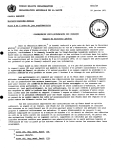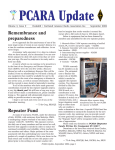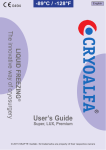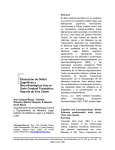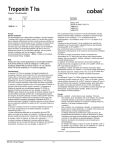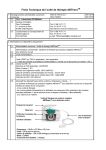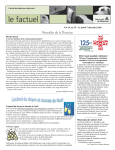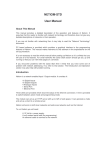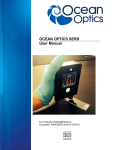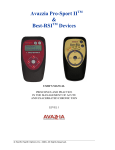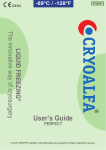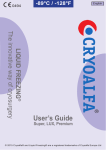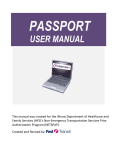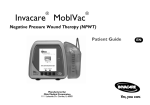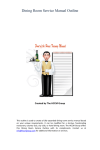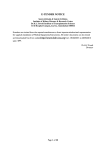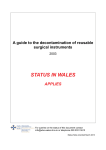Download Vacuum-Assisted Closure™ (V.A.C.)® System for Wounds
Transcript
W0452-08_141 2/24/05 4:44 PM Page 1129 http://evolve.elsevier.com PROCEDURE 141 Vacuum-Assisted Closure™ (V.A.C.)® System for Wounds P U R P O S E : To apply subatmospheric (negative) pressure to the wound bed to stimulate granulation and reduce edema, thus enhancing wound healing. Eleanor R. Fitzpatrick Mary Beth Flynn Makic PREREQUISITE NURSING KNOWLEDGE • Negative-pressure wound therapy, or Vacuum-Assisted Closure™ (V.A.C.®) therapy (V.A.C.® Kinetic Concepts Inc., San Antonio, TX) (Fig. 141-1), is an exclusive system for wound closure that applies subatmospheric (negative) pressure evenly over a wound bed (Fig. 141-2). This mechanical stress creates a noncompressive force on the wound bed that dilates the arterioles, increasing the effectiveness of local circulation and enhancing the proliferation of granulation tissue.1 The system also enhances lymphatic flow and removal of excessive fluid, decreasing wound edema and bacterial load at the wound site, further aiding wound healing1 (Fig. 141-3A and B). • Wound healing is best achieved through adequate cleansing, debridement, and dressing of the wound bed based on patient and wound characteristics. • Wounds heal by either primary or secondary intention (see Fig. 136-1). Most clean or clean/contaminated surgical wounds heal by primary intention. Suturing each layer of tissue approximates the wound edges. These wounds typically heal quickly and require minimal wound care. Contaminated surgical or traumatic wounds (open wounds) heal by secondary intention. • Wounds healing by secondary intention granulate from the base of the wound to the skin surfaces; care must be taken to allow for uniform granulation and prevention of open pockets/tunneling. • Open wounds must be clean and moist to promote effective and efficient wound healing. To that end, open wound care strives to maintain a clean, moist wound bed that allows for effective wound healing under the support of a dressing. • Openly granulating wounds heal more slowly, must remain moist to enhance tissue granulation, and may be more painful for the patient. • Open wounds may have excessive wound drainage, requiring application of absorptive dressings, protection of periwound skin, and more frequent dressing changes to facilitate healing. • The V.A.C.® system is indicated for wounds in which subatmospheric pressure may promote wound healing— for example, chronic, acute, traumatic, subacute, and dehisced wounds, diabetic ulcers, pressure ulcers, flaps, and grafts). The V.A.C.® will draw wound edges together and create a less edematous, clean, vascularized wound bed. The wound may fully heal, or improved adherence of the flap or graft closure can be achieved. • The V.A.C.® has been approved by the Food and Drug Administration (FDA) for clinical use in the treatment of these wounds. A newer system called the Mini VAC® is portable and battery-powered and can be carried by the patient, allowing for increased mobility. The V.A.C.® device requires an electrical outlet for therapy; however, some units have limited battery reserve. Optimal therapy is achieved by delivering uninterrupted therapy at least 22 out of 24 hours (battery power is maintained). From Lynn-McHale Wiegand, D.J., & Carlson, K. K. (2005). AACN Procedure Manual for Critical Care, 5th ed. St. Louis: Elsevier. 1129 W0452-08_141 1130 2/24/05 4:44 PM Page 1130 Unit VII Integumentary System Figure 141-1 Components of the VacuumAssisted Closure™ System. (Kinetic Concepts, Inc., San Antonio, TX.) V.A.C. foam dressing Bone Subcutaneous tissue Capillaries Figure 141-2 V.A.C.® Therapy. Fluid, exudate, and debris removed from wound bed. (Courtesy: Kinetic Concepts, Inc., San Antonio, TX.) From Lynn-McHale Wiegand, D.J., & Carlson, K. K. (2005). AACN Procedure Manual for Critical Care, 5th ed. St. Louis: Elsevier. W0452-08_141 2/24/05 4:44 PM Page 1131 141 Vacuum-Assisted Closure™ (V.A.C.)® System for Wounds 1131 A B Figure 141-3 A, Wound defect. B, Wound defect with V.A.C.® therapy applied. (Courtesy: Kinetic Concepts, Inc., San Antonio, TX.) • Contraindications to use of the V.A.C.® system include malignancy in the wound margins, untreated osteomyelitis, fistulas to organs or body cavities, necrotic tissue with eschar present, exposed arteries or veins in the wound. Precautions should be used for wounds with active bleeding, difficult wound hemostasis, or patients taking anticoagulants.25 • Negative therapy may be applied to the wound by selecting continuous or cycling pressure (intervals of 5 min on/2 min off). After this period the dressing is removed and the wound is cleansed, assessed, and prepared for V.A.C.® therapy to continue if needed. • V.A.C.® dressings are usually changed every 48 hours.3,5,7,13 However, infected wound beds may require more frequent dressing changes (every 12 hours); V.A.C.® dressings over grafts may be changed less frequently (every 3-5 days).3,5,7,13 • The wound bed should be free of necrotic tissue and debris prior to applying the V.A.C.® In highly exudating wounds, draining from the wound bed may be significant in the first 24-48 hours of therapy, requiring monitoring of urine output and hemodynamic stability. Studies have not suggested fluid replacements have been necessary to ensure hemostasis in highly exudating wounds.1,13 • Nutritional requirements for wound healing are great. These needs must be assessed, met, and monitored frequently as fluids and some proteins are removed via V.A.C.® therapy. • Inflammatory cytokines and protein-degrading enzymes impair wound healing and can be removed with negativepressure systems such as the V.A.C.® EQUIPMENT • • • • Personal protective equipment (gown, goggles) Nonsterile and sterile gloves; sterile field Sterile water or normal saline (NS) for cleansing Liquid skin barrier to protect periwound skin and/or hydrocolloid wafer • V.A.C.® collection chamber and suction pump (commercially available) • Sterile foam dressing • Sterile adhesive drape • Noncollapsible evacuation tube • Adhesive drape • Sterile scissors Additional equipment to have available, as needed, includes the following: • Razor PATIENT AND FAMILY EDUCATION • Assess patient and family readiness to learn and any factors that may affect learning. It is also important to identify how best the patient learns. ➸Rationale: Allows the nurse to develop the most appropriate teaching strategy for each patient. • Provide information about the V.A.C.® system, the procedure, and the equipment. ➸Rationale: May decrease or alleviate anxiety by assisting patient and family to understand the procedure, why it is needed, and the preferred outcomes. • Explain the procedure and the reason for changing wound dressing. ➸Rationale: Decreases patient anxiety and discomfort. • Discuss patient’s role in dressing change procedure and maintenance of V.A.C.® ➸Rationale: Elicits patient cooperation; prepares patient for wound management on discharge. PATIENT ASSESSMENT AND PREPARATION Patient Assessment • Fully assess wound to determine its characteristics and appropriateness for the procedure. ➸Rationale: Insures that there is no contraindication to use of the V.A.C.® From Lynn-McHale Wiegand, D.J., & Carlson, K. K. (2005). AACN Procedure Manual for Critical Care, 5th ed. St. Louis: Elsevier. W0452-08_141 2/24/05 1132 • • • • • 4:44 PM Page 1132 Unit VII Integumentary System system. Provides data that can be used for comparison at successive dressing changes. Monitor for signs and symptoms of wound infection, including the following: ❖ Erythema at drainage site ❖ Heat ❖ Edema ❖ Pain ❖ Elevated temperature and white blood cell count ❖ Wound drainage becoming cloudy and foul-smelling ❖ Increasing in amount of wound exudate ➸Rationale: Although negative-pressure wound therapy assists with removal of excessive fluid, thus reducing the presence of bacteria in the wound bed, assessment for signs and symptoms of wound infection is necessary, especially in compromised patients. Determine baseline pain assessment of the patient. ➸Rationale: Provides data that can be used for comparison with past procedure assessment data. Allows the nurse to plan for pre- and intraprocedure analgesia. Determine baseline nutritional status and fluid volume status. ➸Rationale: Fluids and protein may be lost during V.A.C.® therapy. Assess past medical history, especially related to problems with bleeding, fistula formation, or malignancy. ➸Rationale: The use of the V.A.C.® may be contraindicated in these conditions. Assess current medications specifically related to anticoagulant use. ➸Rationale: Identify possible areas of caution which should be monitored with V.A.C.® use. • Assess current laboratory values especially coagulation studies and protein levels. ➸Rationale: Identifies abnormalities possibly associated with risks or areas to monitor related to V.A.C.® use. Patient Preparation • Ensure patient and family understanding of preprocedural teaching. Reinforce teaching points as needed. ➸Rationale: Evaluates understanding of previously taught information and provides a conduit for questions. • Validate presence of patent intravenous access. ➸Rationale: Access may be needed for administration of analgesic medications. • If debridement or other invasive intervention is to be performed in conjunction with the V.A.C.® procedure, ensure that informed consent has been obtained. ➸Rationale: Allows patient to make decision with appropriate information and health care providers can document this. • Position the patient in a manner which will facilitate dressing application and patient comfort. ➸Rationale: Prepares patient to undergo procedure. • Sedate the patient or administer prescribed analgesics if needed. ➸Rationale: Improve comfort level and tolerance of the procedure. Decreases patient anxiety and discomfort. Typically pain medication is not required for V.A.C.® therapy; however, if the patient required analgesia for previous dressing therapy, pain medications may be required for V.A.C.® therapy.1,5 Procedure for Vacuum-Assisted Closure™ (V.A.C.)® System for Wounds Steps Rationale 1. Wash hands and don gloves. Reduces possibility of transmission of microorganisms. 2. Establish a sterile field with all cleansing supplies and materials for appropriately sized V.A.C.® dressing. The V.A.C.® dressing size should be chosen so that it will fill the entire wound cavity. 3. Position the patient to facilitate cleansing and dressing application. Provides for patient comfort and allows for visualization and access to the wound. 4. Cleanse the wound according to orders (see Procedure 136) and/or institution protocol. (Level VI: Clinical studies in a variety of patient populations and situations to support recommendations.) Exudate and debris are removed prior to dressing application. This process facilitates healing and decreases bacterial burden.4,21-22 5. Physician or advanced practice nurse may debride (see Procedure 137) necrotic tissue or eschar if applicable. (Level VI: Clinical studies in a variety of patient populations and situations to support recommendations.) Healthy, vascularized tissue is reached, and with a clean wound bed there is enhanced granulation tissue development.4,6,15,21-23 Special Considerations If extensive debridement is necessary, it may require an operative suite. From Lynn-McHale Wiegand, D.J., & Carlson, K. K. (2005). AACN Procedure Manual for Critical Care, 5th ed. St. Louis: Elsevier. W0452-08_141 3/11/05 8:33 AM Page 1133 141 Vacuum-Assisted Closure™ (V.A.C.)® System for Wounds 1133 Procedure for Vacuum-Assisted Closure™ (V.A.C.)® System for Wounds—Continued Steps Rationale Special Considerations 6. Shave hair on the border around the wound (if needed) and thoroughly cleanse skin surrounding wound. (Level I: Manufacturer’s recommendations only.) Improves dressing adherence. 7. Dry and prepare the periwound tissue as appropriate. Skin degreasing/medical cleansing agents may be necessary to apply to periwound tissue. (Level I: Manufacturer’s recommendations only.) Moisture from perspiration, oil, or body fluids may cause difficulty in achieving an air-tight seal with V.A.C.® dressing. 8. Choose V.A.C.® soft foam (white), a hydrophilic (water-attracting) material or the black foam (polyurethane), a hydrophobic (water-repelling) dressing (Table 141-1). (Level I: Manufacturer’s recommendations only.) White, polyvinyl alcohol foam is denser with smaller pores, which restricts granulation tissue growth into the foam and may be used in cases in which black foam cannot be tolerated due to pain. Larger pores in black foam are considered to be most effective in stimulating granulation tissue and wound contraction. The white V.A.C.® dressing holds moisture but also allows exudate to be removed through it. It is nonadherent and can be used in tunnels and shallow undermining due to its higher tensile strength. The black V.A.C.® dressing does not hold moisture and allows exudates to be removed. Its design results in rapid growth of new granulation. 9. Remove gloves. Wash hands. Apply sterile gloves. 10. Open the V.A.C.® dressing onto sterile, dry surface; inspect it for any defects. Faulty dressings should be replaced. 11. Cut the V.A.C.® foam with sterile scissors in a location away from the wound (Fig. 141-4A). (Level IV: Limited clinical studies to support recommendations.) This prevents small particles from the dressing falling into the wound. The dressing should be cut to fit the size and shape of the wound, including tunnels and undermined areas (Fig. 141-4B). Tunneling can result in a cyst or abscess when the main body of a wound heals Any exposed tendons, nerves, or blood vessels should be protected by moving muscle or fascia over exposed structures or by placing a layer of nonadherent dressing over them. Procedure continues on the following page Table 141-1 Recommended Guidelines for Foam Use V.A.C.® Polyurethane (Black Foam) Deep, acute wounds with moderate granulation tissue growth Deep wounds with extremely rapid growth in granulation tissue Deep pressure ulcers Superficial wounds Shallow chronic ulcers Postgraft therapy Compromised flaps Fresh flaps Tunneling/sinus tracks/undermining Diabetic ulcers Dry wounds Deep trauma wounds Superficial trauma wounds V.A.C.® Soft Foam Both Either X X X X X X X X X X X X X Responsible physician or advanced practice nurse should be consulted for individual patient conditions. Consult device user manual and manufacturer’s recommended guidelines before use. Courtesy Kinetic Concepts, Inc., San Antonio, TX. From Lynn-McHale Wiegand, D.J., & Carlson, K. K. (2005). AACN Procedure Manual for Critical Care, 5th ed. St. Louis: Elsevier. W0452-08_141 2/24/05 A 4:44 PM Page 1134 B D C E Figure 141-4 A and B, Cut the V.A.C.® foam to appropriate size to fill the wound defect. C, Apply V.A.C.® foam into wound bed. D, Apply V.A.C.® tubing to foam in the wound. E, Cover foam and 3 to 5 cm of surrounding healthy tissue with transparent dressing drape to ensure an occlusive seal. (Courtesy Medical Media Department, Thomas Jefferson University Hospital, Philadelphia, PA.) From Lynn-McHale Wiegand, D.J., & Carlson, K. K. (2005). AACN Procedure Manual for Critical Care, 5th ed. St. Louis: Elsevier. W0452-08_141 3/11/05 8:35 AM Page 1135 141 Vacuum-Assisted Closure™ (V.A.C.)® System for Wounds 1135 Procedure for Vacuum-Assisted Closure™ (V.A.C.)® System for Wounds—Continued Steps Rationale Special Considerations and closes the entrance to the tunnel. Bacterial invasion and impaired healing results from unfilled dead space.4,24 12. Size and trim the dressing drape to cover the foam plus a 3-5 cm border of intact skin. Do not discard excess drape. Excess drape may be needed later as a patch. Drape can be placed over prepared skin or the barrier. 13. Gently place the foam into the wound cavity covering the entire wound base and sides as well as areas of tunneling and undermining (Fig. 141-4C). (Level IV: Limited clinical studies to support recommendations.) Capillaries could be compressed if packed too tightly, and pressure on newly formed granulation tissue may prevent or delay healing.4,24 If periwound skin is fragile, use a skin preparation (Matisol®, No-Sting®) prior to drape application or frame the wound with a skin barrier or hydrocolloid dressing. This affords protection for periwound skin. More than one dressing may be needed for larger wounds. More than one piece of foam may be used to fill the wound bed. Foam pieces should be in contact but not overlapping each other to allow equalization of negative pressure applied to the wound bed by the suction device.1,3,5,7,13 14. Apply tubing to foam in the wound. Tubing can be laid on top of the foam or inside the foam dressing. The tubing should be positioned away from bony prominences (Fig. 141-4D). (Level I: Manufacturer’s recommendations only.) This will prevent the development of pressure. For deeper wounds the tubing should be repositioned regularly to minimize pressure on wound edges. Cushion skin under tubing with excess foam. 15. Cover foam and 3 to 5 cm of surrounding healthy tissue with drape to ensure an occlusive seal (Fig. 141-4E). (Level IV: Limited clinical studies to support recommendations.) The vacuum will not function without an occlusive seal. The drape may also help maintain a moist wound environment.2 The drape is vapor-permeable and allows for gas exchange. It also protects the wound from external contamination. Foam will contract into wound bed if seal is obtained. If foam does not contract, reassess outer dressing for possible leaks in the system or dressing seal.1,3,5,7,13 16. Lift the tubing and pinch 1 to 3 cm of drape together under the tubing to help hold the tubing away from the skin and pad underneath the tubing. This will reduce pressure on the skin from the tubing. 17. Avoid stretching the drape and compressing the foam into the wound with transparent occlusive drape. Simply cover and seal around the foam. (Level I: Manufacturer’s recommendations only.) Avoids tension and shearing forces on wound and surrounding tissue. Allows distribution of pressure throughout all wounds with the use of one pump. More than one wound of similar pathology in close proximity can be managed with one negativepressure pump. Such wounds can be bridged by placing the V.A.C.® drape on intact skin and a strip of foam from one wound bed to the other. All edges of the foam should be in contact and the tubing placed in a central location. Procedure continues on the following page From Lynn-McHale Wiegand, D.J., & Carlson, K. K. (2005). AACN Procedure Manual for Critical Care, 5th ed. St. Louis: Elsevier. W0452-08_141 2/24/05 1136 4:44 PM Page 1136 Unit VII Integumentary System Procedure for Vacuum-Assisted Closure™ (V.A.C.)® System for Wounds—Continued Steps Rationale 18. Secure tubing with an additional piece of drape or tape (pad underneath tubing) several centimeters away from the dressing. (Level I: Manufacturer’s recommendations only.) Prevents pull on the primary dressing area, which can cause leaks. 19. Use excess drape to patch leaks and secure borders as needed. Leaks prevent activation of the V.A.C.® system. Applying the V.A.C.® Device 1. Remove canister from the sterile packaging and push it into the V.A.C.® unit until it clicks. If the canister is not engaged properly, it will not function and an alarm will sound. Special Considerations 2. Connect the dressing tubing to the canister tubing, making sure both clamps are open. Closed clamps prevent activation of the negative pressure. 3. Place the V.A.C.® unit on a level surface or hang from the footboard. (Level I: Manufacturer’s recommendations only.) The V.A.C.® unit will alarm and deactivate therapy if the unit is tilted beyond 45 degrees. 4. Press the green-lit power button. Activates subatmospheric pressure therapy. In less than 1 min of operation, the V.A.C.® dressing will collapse unless leaks are present. 5. Adjust the V.A.C.® unit settings based on individual patient’s needs. Variable negative-pressure settings can be chosen, as well as a continuous or intermittent mode (Table 141-2). (Level IV: Limited clinical studies to support recommendations.) Continuous vacuum mode removes cellular edema and debris, enhancing perfusion through vessels previously compressed.1,10,12,14,17,18 Healing inhibitory factors present in this fluid are also removed.20,26 After edema has been sufficiently withdrawn, the intermittent mode promotes granulation tissue formation and prevents wound dehydration.1,8,16,17 Negative pressures ranging from 50 to 175 mm Hg can be chosen, depending on the amount of exudate and granulation tissue within the wound and the type of foam used (see Table 141-2). Premedicate patient if necessary. Application of negative-pressure systems may cause mild discomfort for the patient during initial activation of the V.A.C.® system.1,11 Blood flow may be inhibited by application of higher negative pressures. If you suspect a leak (small leaks may create a whistling noise), gently press around the tubing to better seal the drape. Excess drape can also be used to patch over leaks. Air leaks most often occur around tubing. 6. Slowly increase negative pressure on suction device to desired setting of 125 mm Hg. (Level I: Manufacturer’s recommendations only.) Negative pressure may be initiated at 75 mm Hg and gradually increased to 125 mm Hg. Maintain therapy continuously. Subatmospheric pressure therapy should not be off for more than 2 hr per day. Treatment is discontinued when goals for V.A.C.® therapy are achieved or after 1 to 2 weeks without improvement in the condition of the wound. Physician or advanced practice nurse will order desired negative-pressure settings. Lower pressure settings may be ordered for special wound beds (meshed grafts); higher pressure settings (125-175 mm Hg) may be ordered for high-effluent wounds.1,3,5,7,13 V.A.C.® therapy is delivered for 48 hr. After this period the dressing is removed and the wound cleansed, assessed, and prepared for V.A.C.® therapy to From Lynn-McHale Wiegand, D.J., & Carlson, K. K. (2005). AACN Procedure Manual for Critical Care, 5th ed. St. Louis: Elsevier. W0452-08_141 2/24/05 4:44 PM Page 1137 141 Vacuum-Assisted Closure™ (V.A.C.)® System for Wounds 1137 Table 141-2 Recommended Guidelines for Treating Wound Types with V.A.C.® System Target Pressure for Black Polyurethane Dressing Target Pressure Polyvinylalcohol Soft Foam Intermittent (5 min on/2 min off) for rest of therapy Intermittent (5 min on/2 min off) for rest of therapy Continuous 125 mm Hg 125-175 mm Hg Every 48 hr (every 12 hr with infection) 125 mm Hg 125-175 mm Hg (titrated up for increased drainage) 125 mm Hg; (titrated up for increased drainage) Every 48 hr (every 12 hr with infection) 125 mm Hg Subsequent Cycles Wound Type Initial Cycle Acute/traumatic wound Continuous for first 48 hr Surgical wound dehiscence Continuous for first 48 hr Meshed graft Continuous Pressure ulcer Continuous for first 48 hr Chronic ulcer Continuous Intermittent (5 min on/2 min off) for rest of therapy Continuous Fresh flap Continuous Continuous 125-150 mm Hg Compromised flap Continuous Continuous 125 mm Hg 75-125 mm Hg 50-125 mm Hg 125-175 mm Hg (titrated up for increased drainage) 125-175 mm Hg (titrated up for increased drainage) 125-175 mm Hg (titrated up for increased drainage) 125-175 mm Hg (titrated up for increased drainage) Dressing Change Interval None; remove dressing after 4-5 days when using either foam Every 48 hr (every 12 hr with infection) Every 48 hr (every 12 hr with infection) Every 72 hr (every 12 hr with infection) Every 48 hr (every 12 hr with infection) Responsible physician or advanced practice nurse should be consulted for individual patient conditions. Consult device user manual and manufacturer’s recommended guidelines before use. Courtesy Kinetic Concepts, Inc., San Antonio, TX. Procedure for Vacuum-Assisted Closure™ (V.A.C.)® System for Wounds—Continued Steps Rationale Special Considerations continue if needed. If infection is present, the dressing change interval should be every 12 to 24 hr. Negative pressure may enhance bacterial clearance from the wound.9,11,19 Dressing Removal 1. To remove the dressing, raise the tubing connector above the level of the pump unit. Drains fluid from tubing into canister. 2. Tighten clamps on the dressing tube. Prevents leakage. 3. Separate canister tube and dressing tube by disconnecting the connector. Allows canister to be emptied and/or discarded. 4. Allow the pump unit to pull the exudate in the canister tubing into the canister; then tighten clamps on the canister tube. Removes any remaining fluid from the dressing. 5. Press Therapy button Off. Deactivates pump. 6. Gently stretch drape horizontally and slowly pull up from skin. Do not peel. Gently remove. Decreases patient discomfort and potential for skin and wound trauma. 7. Discard disposables according to institution policy. Reduces transmission of microorganisms; universal precautions. 8. Document procedure in patient record. From Lynn-McHale Wiegand, D.J., & Carlson, K. K. (2005). AACN Procedure Manual for Critical Care, 5th ed. St. Louis: Elsevier. W0452-08_141 2/24/05 1138 4:44 PM Page 1138 Unit VII Integumentary System Expected Outcomes Unexpected Outcomes • Wound healing/granulation enhanced by consistent negative-pressure therapy; early signs of contraction of wound margins • Decreased volume of wound exudate (over time) and absence of foul odor or color • Enhanced wound healing because of effective wound fluid/edema removal • Decrease in size of wound with ability for surgical closure with flap/graft or skin graft; complete healing of wound • Decreased time to satisfactory healing (may decrease hospital length of stay and cost) • • • • • • • • • • Infection Bleeding Fistula formation Disruption of underlying tissue/structures Pain Misplacement over exposed vessel, ligaments, other structures Lack of improvement in wound after 1 to 2 weeks of therapy Tissue loss Ischemia and necrosis Skin erosion or maceration around wound sites, or pressure breakdown at dressing tubing site, or both Patient Monitoring and Care Steps Rationale Reportable Conditions These conditions should be reported if they persist despite nursing interventions. • Tissue breakdown 1. Assess location of wound and placement of V.A.C.® evacuation tube to avoid excessive pressure on surround tissue/structures. Excessive pressure may result in tissue breakdown at evacuation tube site. 2. Assess patency of V.A.C.® system. The V.A.C.® dressing should be collapsed when seal is maintained and negative pressure is being delivered in a consistent manner. Alarms on the device indicate loss of seal; raised foam dressing indicates loss of negative-pressure therapy. • Loss of seal • Raised foam dressing • Wound drainage suddenly decreasing in amount or stopping 3. Monitor condition of wound bed and periwound skin with dressing changes; observe for signs of wound infection. Identifies any evidence of wound healing or of any changes or abnormalities indicative of complications. • Erythema at drainage site • Heat, edema, pain • Elevated temperature and white blood cell count • Cloudy or foul-smelling wound drainage • Increased wound drainage • Excess bleeding • Discolored tissue in wound bed • Macerated periwound skin • New tunneling or undermining 4. Change the dressing every 48 hr. If infection is present, increase the frequency of dressing change to every 12 to 24 hr. (Level II: Theory-based, no research data to support recommendations: recommendations from expert consensus group may exist.) Removes infectious material from • Signs or symptoms of infection a healing wound bed. (erythema, heat, discolored or If dressing adheres to the wound base, purulent drainage, fever) consider imposing a single layer of nonadherent porous material (e.g. wide-meshed Vaselineimpregnated gauze) between the dressing and the wound when reapplying the dressing. The nonadherent material must have wide enough pores to allow unrestricted passage of air and fluid. Because tissue growth into the V.A.C.® dressing may cause adherence, also consider more frequent dressing changes. From Lynn-McHale Wiegand, D.J., & Carlson, K. K. (2005). AACN Procedure Manual for Critical Care, 5th ed. St. Louis: Elsevier. W0452-08_141 2/24/05 4:44 PM Page 1139 141 Vacuum-Assisted Closure™ (V.A.C.)® System for Wounds 1139 Patient Monitoring and Care—Continued Steps Rationale Reportable Conditions If previous dressings were difficult to remove, make sure the dressing tubing is unclamped; introduce 10 to 30 ml of NS solution into the tubing to soak underneath the foam for 15 to 30 min. NS can be injected directly into the foam while low vacuum (50 mm Hg) is applied to the dressing. Clamp the tube when the NS starts to flow into the dressing tube. Wait 15 to 30 min; then gently remove dressing. If the patient experiences pain during dressing change, 1% lidocaine solution may be ordered by the physician or advanced practice nurse. This can be introduced down the tubing or injected into the foam with the pump turned on at a lower pressure (50 mm Hg). After instilling the lidocaine, clamp the tube and wait 15 to 20 min before gently removing the dressing. 5. Monitor the mode (continuous or intermittent) and level of suction (50-175 mm Hg). (Level IV: Limited clinical studies to support recommendations.) Removal of edema and debris alleviates compressive forces, thus improving perfusion. Suctioning fluid from within the wound may remove factors that inhibit healing.25 Negative-pressure wound therapy decreases the bacterial load of deliberately infected wounds.1 Application and release of force on tissue stimulates cell proliferation and protein synthesis. Mechanical stretch on the tissue by the negative pressure draws the wound toward the center closing the defect.16 Once edema of the wound has resolved (typically after 48 hr of continuous therapy) the intermittent mode allows a more aggressive stimulus for granulation tissue formation, possibly due to rhythmic perfusion or increased cell mitosis stimulated by a rest and stimulation cycle.1,8,17 6. Maintain an air tight seal. (Level I: Manufacturer’s recommendation only.) Loss of an air-tight seal can result in a decreased amount of drainage removal and in desiccation of the wound. 7. Use sterile technique with new dressing application. Prevents bacterial contamination of system. 8. Label dressing with date and time of application. Identifies when system should be changed. 9. Keep canister position level. Prevents malfunction of suction apparatus and an inoperative status. • Patient discomfort • Excess granulation tissue overgrowth into the dressing when removed • Continued edema within wound bed Procedure continues on the following page From Lynn-McHale Wiegand, D.J., & Carlson, K. K. (2005). AACN Procedure Manual for Critical Care, 5th ed. St. Louis: Elsevier. W0452-08_141 2/24/05 1140 4:44 PM Page 1140 Unit VII Integumentary System Patient Monitoring and Care—Continued Steps Rationale Reportable Conditions 10. The V.A.C.® canister should be changed when full (unit will alarm) or at least weekly. Label with date and time of change. Controls odor. • Wound drainage becoming foul-smelling and cloudy 11. Monitor amount of wound drainage. (Level II: Theory-based; no research data to support recommendations: recommendations from expert consensus group may exist.) If a wound produces excessive fluid, the patient may experience a fluid imbalance, requiring intravenous or oral fluid replacements. Excess drainage may also result in some protein loss. Nutritional consult to replace protein loss from wound exudates may be indicated. • Increasing amounts of drainage • Tachycardia • Hypotension • Oliguria • Decreasing serum protein levels 12. Encourage patient hygiene, shower, or bath during V.A.C.® dressing changes. Documentation Documentation should include the following: • • • • • • • Patient and family education Patient tolerance of the procedure Condition of the wound bed and periwound skin description Characteristics of wound drainage Degree of suction (mm Hg) and continuous or intermittent mode Nursing interventions Premedication given and patient’s response to the pain medication References 1. Argenta, L.C., and Morykwas, M.J. (1997). Vacuum-assisted closure: A new method for wound control and treatment: clinical experience. Ann Plastic Surg, 38, 563-76. 2. Banwell, P.E. (1999). Topical negative pressure therapy in wound care. J Wound Care, 8, 79-84. 3. Bates-Jensen, B.M., et al. (2001). Management of the wound environment with advanced therapies. In: Sussman, C., and Bates-Jensen, B.M., eds. Wound Care. 2nd ed. Gaithersburg, MD: Aspen Publication, 272-92. 4. Bergstrom, N., et al. (1994). Treatment of pressure ulcers. Clinical Practice Guideline, No. 15. Rockville, MD: U.S. Department of Health and Human Services, Public Health Service, Agency for Healthcare Policy and Research, AHCPR Publication No. 95-0652. 5. Chua-Patel, C.T., et al. (2000). Vacuum-assisted wound closure. Am J Nurs, 100, 45-8. 6. d’Udekem, Y., et al. (1998). Radical debridement and omental transposition for post-sternotomy mediastinitis. Cardiovasc Surg, 6, 415-8. 7. Evans, D., and Land, L. (2001). Topical negative pressure for treating chronic wounds. The Cochrane Database of Systematic Reviews, 4:CD001898. 8. Fabian, T.S., et al. (2000). The evaluation of subatmospheric pressure and hyperbaric oxygen in ischemic, full-thickness wound healing. Am Surg, 66, 1136-43. 9. Ford, C.N., et al. (2001). Interim analysis of a prospective, randomized trial of a vacuum-assisted closure versus the • Wound debridement procedure (if applicable), wound cleansing procedure completed, dated, and timed • Size of the wound measured by length, width, and depth (consider obtaining a photograph of the wound, depending on institution policy) • Size and type of V.A.C.® foam dressing applied and total number placed in the wound • Unexpected outcomes, reportable conditions healthpoint system in the management of pressure ulcers. Ann Plast Surg, 49, 55-61. 10. Genecov, D.G., et al. (1998). A controlled subatmospheric pressure dressing increases the rate of skin graft donor site re-epithelialization. Ann Plast Surg, 40, 219-25. 11. Hersh, R.E., et al. (2001). The vacuum-assisted closure device as a bridge to sternal closure. Ann Plast Surg, 46, 250-4. 12. Joseph, E., et al. (2000). A prospective randomized trial of vacuum-assisted closure versus standard therapy of chronic, nonhealing wounds. Wounds, 12, 60-7. 13. Kirby, J.P., et al. (2002). Novel uses of a negative pressure wound care system. J Trauma, 53, 117-21. 14. McCallon, S.K., et al. (2000). The effectiveness of vacuumassisted closure vs. saline moistened gauze in the healing of post-operative diabetic foot wounds. Ostomy/Wound Manage, 46, 28-35. 15. Meara, J.G., et al. (1999). Vacuum-assisted closure in the treatment of degloving injuries. Ann Plast Surg, 42, 589-94. 16. Morykwas, M.J., and Argenta, L.C. (1997). Nonsurgical modalities to enhance healing and care of soft tissue wounds. J South Ortho Assoc, 6, 279-88. 17. Morykwas, M.J., et al. (1997). Vacuum-assisted closure: a new method for wound control and treatment: Animal studies and basic foundation. Ann Plast Surg, 38, 553-62. 18. Mullner, T., et al. (1997). The use of negative pressure to promote the healing of tissue defects: A clinical trial using the vacuum seal technique. Br J Plast Surg, 50, 194-9. From Lynn-McHale Wiegand, D.J., & Carlson, K. K. (2005). AACN Procedure Manual for Critical Care, 5th ed. St. Louis: Elsevier. W0452-08_141 2/24/05 4:44 PM Page 1141 141 Vacuum-Assisted Closure™ (V.A.C.)® System for Wounds 19. Obdeijn, M.C., et al. (1999). Vacuum-assisted closure in the treatment of poststernotomy mediastinitis, Ann Thorac Surg, 68, 2358-60. 20. Philbeck, T.E., et al. (1999). The clinical and cost effectiveness of externally applied negative pressure wound therapy in the treatment of wounds in home healthcare Medicare patients. Ostomy/Wound Manage, 45, 41-50. 21. Rodeheaver, G., et al. (1994). Wound healing and wound management: Focus on debridement. Adv Wound Care, 7, 22-4, 26-9, 32-6. 22. Sibbald, R.G., et al. (2000). Preparing the wound bed-debridement, bacterial balance and moisture balance. Ostomy/Wound Manage, 46, 14-35. 23. Steed, D.L., et al. (1996). Effect of extensive debridement and treatment on the healing of diabetic foot ulcers. Diabetic Ulcer Study Group. J Am Coll Surg, 183, 61-4. 24. Stotts, N. (1997). Co-factors in impaired wound healing. In: Krasner, D., and Kane, D., eds. Chronic Wound Care: A Clinical Source Book for Healthcare Professionals. 2nd ed. Wayne, PA: Health Management Publications, Inc. 25. Wysocki, A.B. (1996). Wound fluids and the pathogenesis of chronic wounds. J WOCN, 23, 283-90. 26. www.kci1.com/clinicalevidence/indexVAC. Accessed May 17, 2004. Additional Readings Barker, D.E., et al. (2000). Vacuum pack technique of temporary abdominal closure: A 7-year experience with 112 patients. J Trauma, 48, 201-7. 1141 Casey, G. (2003). Nutritional support in wound healing. Nurs Stand, 17, 55-6, 58. Dolynchuk, K. (2000). Best practices for the prevention and treatment of pressure ulcers. Ostomy/Wound Manage, 46, 38-52. Erdman, D., et al. (2001). Abdominal wall defect and enterocutaneous fistula treatment with the vacuum-assisted (V.A.C.) system. Plast Reconstr Surg, 108, 2066-8. Falanga, V., ed. (2000). Text Atlas of Wound Management. London: Martin Dunitz Ltd. Falanga, V., ed. (2001). Cutaneous Wound Healing. London: Martin Dunitz Ltd. Irion, G. (2002). Comprehensive Wound Management. Thorofare, NJ: Slack Incorporated. Kinetic Concepts, Inc. (2001). V.A.C. Physician and Caregiver Reference Manual. San Antonio: Kinetic Concepts, Inc. Kloth, L.C., and McCulloch, J.M., eds. (2002). Wound Healing: Alternatives in Management. 3rd ed. Philadelphia: F.A. Davis Company. Krasner, D.L., et al. (1999). Nursing management of chronic wounds. Nurs Clin N Am, 34, 933-949. Krasner, D.L. (2002). Managing wound pain in patients with vacuum-assisted closure devices. Ostomy/Wound Manage, 48, 38-43. Mendez-Eastman, S. (2001). Guidelines for using negative pressure wound therapy. Adv Skin & Wound Care, 14, 314-22. Mendez-Eastman, S. (1999). Use of hyperbaric oxygen and negative pressure therapy in the multidisciplinary care of a patient with nonhealing wounds. J Wound Ostomy Continence Nurs, 26, 67-76. http://evolve.elsevier.com From Lynn-McHale Wiegand, D.J., & Carlson, K. K. (2005). AACN Procedure Manual for Critical Care, 5th ed. St. Louis: Elsevier.













